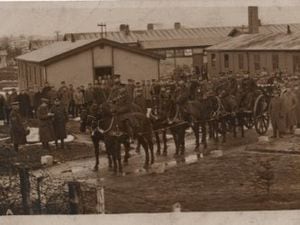Coronavirus one year on: Our twelve months of fear, despair, hope
It barely registered as a footnote in the day’s news.

As Nigel Farage and his supporters prepared for their 11pm party in Parliament Square to celebrate Britain’s departure from the EU, reports of two Chinese nationals testing positive for coronavirus in York slipped through almost unnoticed. Compared to the news that Brexit was finally happening after three-and-a-half years of wrangling, two overseas visitors being taken ill in an hotel room was always going to take second place.
What a difference a year makes.
It is 12 months tomorrow since the first cases of Covid-19 were recorded in the UK. This week the number of lives lost to the disease passed the 100,000 mark.
But things seemed so different a year ago. While there were some concerns the new killer bug had reached these shores, there was no need to panic, was there? Sure, the previous week Public Health England had raised the alert level from ‘very low’ to ‘low’. But we had been here before. In the previous 20 years there had been Sars, Chinese bird flu and then swine flu. These diseases came and went, but for most life went on as before.
Millions
A year ago the new virus had claimed 213 lives, all of them in China. Last week, the daily death toll in the UK peaked at more than 1,800. More than 3.5 million people have so far tested positive for the virus in this country.
News of the Britain’s first coronavirus cases broke as 83 Britons were airlifted from the Chinese city of Wuhan, where the outbreak began. They were taken to Arrowe Park Hospital in Wirral in a fleet of coaches, where they were kept in isolation for 14 days. Chief medical officer for England, Prof Chris Whitty, said there was no need for alarm, adding that the NHS was “extremely well-prepared for managing infections”. Indeed, a review the previous year found that Britain was one of the best prepared countries in the world for a pandemic. The problem was, it was prepared for the wrong type of pandemic.
Up until 2020, all planning had been based on the assumption the next major pandemic to sweep the world would be a flu-like virus rather than a coronavirus.
Prof Devi Sridhar of Edinburgh University, says it was assumed the virus could not be contained and instead had to be managed. She says while countries such as Taiwan, Singapore and South Korea, which had experience of dealing with the likes of Sars, already had test-and-trace systems in place, Europe and the US were caught on the hop.
Advice
Britain became the 23rd country in the world to record the infection, days after the first cases were reported in Germany and France.
On February 6, after another case was detected in Brighton, the Government told travellers arriving from nine east-Asian countries to check for symptoms. They were advised to stay at home, and call the NHS if they felt unwell.
But Covid was getting closer. On February 8 it emerged West Midland lorry driver Alan Steele was in isolation after testing positive while on a cruise ship for his honeymoon. Mr Steele, 58, who had just married Wolverhampton-based nurse Wendy in Little Drayton, Shropshire, was on the Diamond Princess which had been quarantined off Yokohama Bay in Japan. On February 28 another passenger became the first British person to die from the virus. By March 16, at least 712 of the Princess’s 3,711 passengers had tested positive. By the following month, 14 had died.
The first coronavirus deaths on UK soil came on March 5. The first was a woman in her 70s, who died at the Royal Berkshire Hospital in Reading, followed the same day by a man in his early 80s at Milton Keynes Hospital. Both had underlying health conditions.
Crisis
A week later, the number of new cases surged by 590 in a single day, and medical officers raised the threat level from medium to high. It was now clear Britain – and the rest of the world – was in the grip of a full-blown crisis.
First, Prime Minister Boris Johnson advised anybody with a ‘new, persistent cough’ to isolate for a week, but this would quickly escalate. On March 20, the Government ordered pubs, restaurants, gyms, nightclubs, theatres and cinemas to close. Professional football was suspended, initially for three weeks.
But there was more to come. The following week, in a televised broadcast, Mr Johnson essentially told everyone to stay at home for three months, only venturing out when truly essential. Lockdown had begun.
Then followed a spring and summer like none we had ever experienced.
The initial response was broadly positive, although the Prime Minister was said to have been nervous about how long the public’s cooperation would last. He was said to be fearful that if he announced lockdown too early, people’s willingness to comply could wane when it was needed most.
Intensive care
Mr Johnson would soon discover just how brutal Covid could be when he contracted the disease himself and there were real fears he would die. On April 6 he was placed in intensive care, and at one point there were fears he might not pull through. Health Secretary Matt Hancock and the Prince of Wales also contracted the virus. The daily death toll peaked at 1,122 on April 10, and then started to fall sharply. By the summer, it appeared lockdown had worked, and the virus was largely under control. There were no deaths recorded on July 30, but that didn’t last.
As summer gave way to autumn, concerns grew that a much-feared second wave was on its way. Students were confined to their rooms as the virus spread around university campuses, and a second four-week lockdown was announced in November. But there was worse to come. Much worse.
Days after wishing everybody a “Merry Little Christmas”, Mr Johnson was forced to make a swift U-turn after a new, faster-spreading strain of the virus was discovered in Kent. The south-east of England was placed under a third lockdown in all but name, and by the start of the year the whole country was once more being told to stay at home.
The approval of two new coronavirus vaccines has produced a ray of hope. So far, seven million people have been vaccinated, and the Government is pinning its hopes on some sort of normality by spring. But a year on, as the UK became only the fifth country in the world to pass 100,000 fatalities, questions are bound to be asked about whether more could have been done to prevent the spread of the virus.
Breeding ground
As a densely packed country, the UK was always going to suffer more than most. London’s role as an international commercial centre meant the virus reached Britain quickly, and the busy, crowded capital provided the perfect breeding ground for it to spread like wildfire. And while it might not have convinced Piers Morgan, having an ageing, obese population also played a role.
When the inevitable inquiry is held into how the UK handled the pandemic, the Government will probably be given credit for its rapid delivery of the vaccine, with which it can rightly claim to have led the world. And while the pandemic has certainly taken its toll on hospitals, the NHS has risen to the challenge admirably. The appalling images of hospitals in Italy collapsing under the strain have largely been avoided.
Yet many will argue those same pictures, of dying patients being left on the floors of Italian hospitals, should have jolted the Government into acting quicker.
Should Britain have closed itself the moment it saw what was happening to our European neighbours? Should the lockdown have come sooner? That appears to have been the view of Home Secretary Priti Patel in a leaked video calling for borders to have been shut in March, an allegation which has not been disputed by Downing Street.
This week, the Prime Minister said he mourned every one of the 100,000 who died from the virus, and only the harshest of cynics would doubt that he meant it.
But the question he will face over years to come will be, with the benefit of hindsight, could many of these deaths have been avoided?





